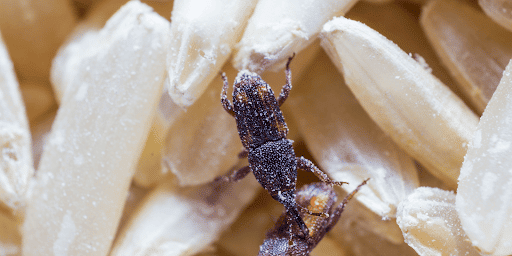
If you’ve ever opened your cupboard and spotted a strange, long-snouted insect darting for cover, you’re likely dealing with a grain weevil. These tiny pests may look like creatures from another world, but they’ve been around for centuries, making a home in our grains and dry goods. Grain weevils aren’t just a modern problem — they’ve been infesting food storage since ancient times, damaging crops and pantry staples along the way.
In this article, I’ll dive into what makes these little bugs so resilient, explore their fascinating history, and share some effective ways to keep them out of your kitchen.
Different Kinds of Weevils
Over 97,000 species of weevils, part of the Curculionidae family (order Coleoptera), infest crops worldwide. These beetles attack grains like rice, cotton, wheat, and barley, causing widespread damage. Weevils, known for their elongated snouts called rostrums, vary in shape, size, and color, but they typically measure about a quarter of an inch. Depending on the species, they can appear brown, green, blue, white, yellow, black, or red, often with distinct spots or splotches.
Weevils have been infesting human food stores and lowering grain quality for thousands of years. Some of the earliest evidence of weevil infestations is in Egyptian tombs dating to 2300 B.C. They have also been found in Amarna stables from the 14th century B.C.
If you’re dealing with a weevil infestation, you’re most likely up against “stored product” weevils. Stored product pests infest sealed fruits, nuts, grains, pasta, cereals, and the like. Weevils are a common stored-product pest, along with pantry flies, several moths, and other types of grain beetles. Pantry pests can be a nuisance to manage, multiplying quickly and becoming an infestation while destroying your dry goods. Thankfully, while unpleasant to deal with, weevils don’t typically carry diseases, bite, or damage your home. If you find a weevil in your pantry, you’re most likely dealing with one of three common species, the maize weevil, rice weevil, or granary weevil.
Maize and Rice Weevils

Maize weevils (Sitophilus zeamais) and rice weevils (Sitophilus oryzae) are close cousins and similar in appearance and behavior. They’re extremely small, even by weevil standards. Their color ranges from dark to reddish-brown, rust, and black, sometimes accompanied by yellow or red dots. They both have shiny pits along their carapace and antennas along their rostrum. Adults can fly, equipped with a pair of small, fully functioning wings. While they get their names from infesting maize and rice, respectively, homeowners can find them in:
- Wheat
- Dried peas
- Oats
- Cereal
- Pasta
- Beans
- Birdseed
- Sunflower seeds
- Grapes
- Stored cotton
- Pears
- Apples
Granary Weevil

The granary weevil (Sitophilus granarius), or wheat weevil, is slightly larger than rice and maize weevils, about 2.5 to 5.0 millimeters in length. It has a long, cylindrical body with a dark brown to black coloration. It has an elongated head with a more sharply curved snout than other weevils. It also lacks the ability to fly and isn’t attracted to light. Granary weevils infest dried grains and cereal products, including:
- Corn
- Rice
- Cereal
- Macaroni
- Spaghetti
- Oats
- Barley
- Rye
- Various seeds
- Buckwheat
- Beans
- Grain sorghum
The Life Cycle of a Weevil
One of the most frustrating things about weevils is that they lay their eggs inside grain kernels. A weevil infestation typically begins with one of these egg-bearing kernels. Your dried goods may already have one inside, or a weevil will sneak into a container and lay eggs. The egg then pupates inside the kernel and hatches into its larval stage. These weevil pupae look like small, fleshy, maggot-like grubs. The weevil larvae will feed on surrounding grain products for about three weeks before maturing. They’ll then seek out new grain to lay eggs.
During their life cycle, weevils may stay in a single package of grain products unless something disturbs them or they try to migrate to another nearby package. As a result, weevils can be extremely difficult to detect until you open a pack of pasta, only to find a swarm of small invaders.
How Do You Prevent Weevils?
Sometimes, preventing weevils is impossible, like when you buy a product with an infested kernel. However, these situations are highly unlikely, and your best bet is to prevent adult weevils from getting in and laying eggs. I recommend these steps to prevent pests from raiding your pantry:
Thoroughly Inspect Wheat and Grain Products
Weevils can come to infest storage facilities or warehouses. In these situations, weevils can cut small holes and burrow into packed items. When shopping, always carefully inspect the outside of the container, looking out for small holes.
Keep Your Kitchen and Pantry Clean
Keeping a clean kitchen is a good homeowner habit and a valuable pest control practice. A messy kitchen and pantry will attract all manner of pests, weevils included. Be sure to clean your kitchen often, and I recommend fully cleaning out your panty at least once a month. Keep entry points into your home sealed because weevils, like most pests, can enter the home through small openings. I recommend doing a yearly outdoor home inspection at the end of summer, sealing all cracks and crevices, and replacing weather stripping and screens.
Store Food in Airtight Containers
Weevils have small, chewing mouthparts within their snouts. They can’t inflict bites but can slowly chew through paper, cardboard, and plant matter. Keeping your dry food in plastic containers makes them functionally weevil-proof.

How To Get Rid of Weevils
While harmless to humans and homes, weevils can be an irritating nuisance. They’re extremely difficult to detect early and can quickly spread to overtake a whole pantry. If you encounter weevils in your home, you can easily dispose of them using the following methods:
- Remove all infested products from your pantry: If you see weevils crawling on or inside a dry good, dispose of it immediately.
- Throw away all other unsealed dry goods in your pantry: If you find weevils in one item, odds are they have infested every unsealed product in your pantry. If you have any dry goods that are not sealed, you’re better off throwing them away. Anything kept inside a sealed container or plastic bag is fine. If your dry goods are sealed, thoroughly check the outside of the container. The item has to go if you spot any small holes, tears, or breaks in the seal.
- If you’re unsure about a product, freeze it: If you find a bag or box of grains that you are unsure about or suspect weevils may have gotten into, you may be able to salvage it by freezing its contents. Leave it sealed inside the freezer for one week, and it should kill any eggs and larvae that might be inside.
- Clean, sterilize, and repackage: After removing everything from the pantry, your next step is cleaning and sterilizing it. Start by vacuuming all the dust, dirt, and debris from the floors and shelves. Then clean and disinfect the shelves with hot soapy water, vinegar, or other food-safe cleaners. Abrasive cleaners like bleach or ammonia are unnecessary, and you should avoid using insecticides and pesticides as most are ineffective against weevils. After everything has been cleaned and had a chance to dry, place all items back inside the pantry.
Final Thoughts on Weevils
Weevils may be a frustrating nuisance, but they are harmless to humans and homes. They don’t carry diseases, and their inability to bite makes them more of an inconvenience than a threat. If you catch them early, you can quickly remove infested items and thoroughly clean the area. While most weevil infestations don’t require professional pest control services, larger outbreaks can occur, particularly in environments like farms with significant grain storage or abandoned homes.
To keep your pantry free of these pests, make prevention your top priority. Regularly inspect grain products, maintain cleanliness in your kitchen, and make sure all food is stored in airtight containers. By staying proactive and vigilant, you can manage potential infestations and keep your home weevil-free.
Frequently Asked Questions
How do you get rid of grain weevil?
To get rid of grain weevils, throw away any infested items and thoroughly clean your pantry by vacuuming shelves and wiping surfaces with white vinegar. Store dry goods in airtight containers, and if you’re unsure about any food, freeze it for a week to eliminate any eggs or larvae.
What does a grain weevil do?
Grain weevils feed on and damage stored grains, such as wheat and rice, reducing their quality, and contaminating them with their excrement. They can infest entire batches of grain, leading to significant losses in both weight and quality.
What attracts grain weevils?
Grain weevils are attracted to warm, moist environments and the scent of grains like rice, wheat, and oats, as well as spilled grains and improperly sealed containers.






Leave a Reply